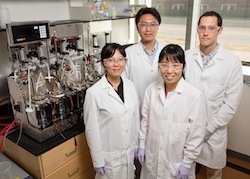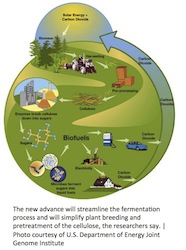 Scientists from the University of Illinois have reported that they have engineered yeast to consume acetic acid, a previously unwanted byproduct of the process of converting plant leaves, stems and other tissues into biofuels. This innovation increases ethanol yield from lignocellulosic sources (aka second generation feedstocks) by nearly 10 percent. According to researchers, the new advance will streamline the fermentation process and will simplify plant breeding and pretreatment of the cellulose. The results were published in Nature Communications.
Scientists from the University of Illinois have reported that they have engineered yeast to consume acetic acid, a previously unwanted byproduct of the process of converting plant leaves, stems and other tissues into biofuels. This innovation increases ethanol yield from lignocellulosic sources (aka second generation feedstocks) by nearly 10 percent. According to researchers, the new advance will streamline the fermentation process and will simplify plant breeding and pretreatment of the cellulose. The results were published in Nature Communications.
Lignocellulose is the fibrous material that makes up the structural tissues of plants. It is one of the most abundant raw materials on the planet and, because it is rich in carbon it is an attractive source of renewable biomass for biofuels production.
The researchers explain that the yeast Saccharomyces cerevisiae is good at fermenting simple sugars (such as those found in corn kernels and sugarcane) to produce ethanol. But coaxing the yeast to feast on plant stems and leaves is not so easy. Doing it on an industrial scale requires a number of costly steps, one of which involves breaking down hemicellulose, a key component of lignocellulose.
“If we decompose hemicellulose, we obtain xylose and acetic acid,” said University of Illinois food science and human nutrition professor Yong-Su Jin, who led the research with principal investigator Jamie Cate, of the University of California at Berkeley and the Lawrence Berkeley National Laboratory. Jin and Cate are affiliates of the Energy Biosciences Institute (EBI), which funded the research. Jin is an affiliate of the Institute for Genomic Biology at the U of I.
“Xylose is a sugar; we can engineer yeast to ferment xylose,” Jin said. “However, acetic acid is a toxic compound that kills yeast. That is one of the biggest problems in cellulosic ethanol production.”
In an earlier study, graduate student Soo Rin Kim (now an EBI fellow) engineered S. cerevisiae to more efficiently consume xylose. This improved ethanol output, but the process generated an excess of NADH, an electron-transfer molecule that is part of the energy currency of all cells. The buildup of acetic acid also killed off much of the yeast.
 After discussing the problem with Jin, Cate had an idea – perhaps the team could induce the yeast to consume acetic acid. It later occurred to Jin that that process might also use up the surplus NADH from xylose metabolism.
After discussing the problem with Jin, Cate had an idea – perhaps the team could induce the yeast to consume acetic acid. It later occurred to Jin that that process might also use up the surplus NADH from xylose metabolism.
Also when reviewing earlier studies, postdoctoral researcher Na Wei found that another organism, a bacterium, could consume acetic acid. She identified the enzymes that catalyzed this process and saw that one of them not only converted acetic acid into ethanol, but also would use the surplus NADH from xylose metabolism.
To get a better idea of the feasibility of the idea, graduate student Josh Quarterman used computer simulations to see how adding the new genes to the yeast’s metabolic repertoire would affect its ethanol output. His calculations indicated that the pathway Wei had identified would boost ethanol production.
Next, Wei did the detailed work of inserting the desirable genes into the yeast, a process that took several months. When she tested the yeast, she saw that it produced about 10 percent more ethanol than before, in line with Quarterman’s calculations. In further experiments, she demonstrated that the new yeast was in fact making some of the ethanol from acetate, a first for S. cerevisiae.
“We sort of rebuilt how yeast uses carbon,” Cate said.
The breakthrough also will help those who focus on other steps in the biofuels production process, Jin said. Plant geneticists and those involved in pretreatment can stop worrying about finding ways to eliminate acetic acid from lignocellulose.
“Many people are curious about why we don’t have cellulosic biofuel right now,” Jin added. “But it’s not because of one limiting step. We have many limiting steps in growing the biomass, storing, moving, harvesting, decomposing the biomass to the sugar, fermentation and then separation (of the ethanol). The advance that we are reporting involves one of those steps – fermentation. But it also will make other steps in the process a little easier.”

